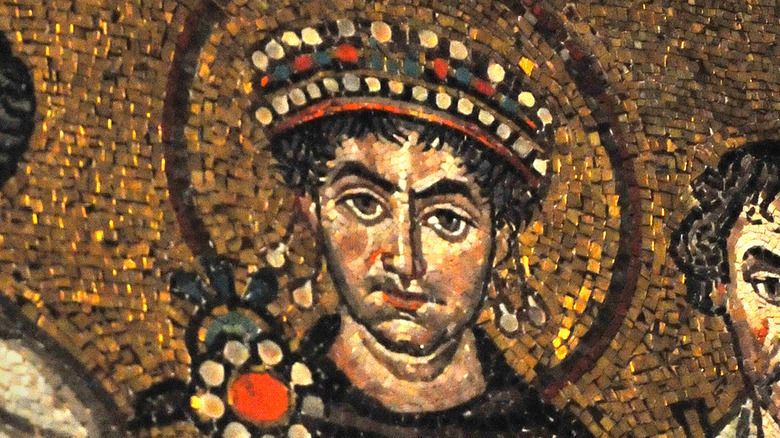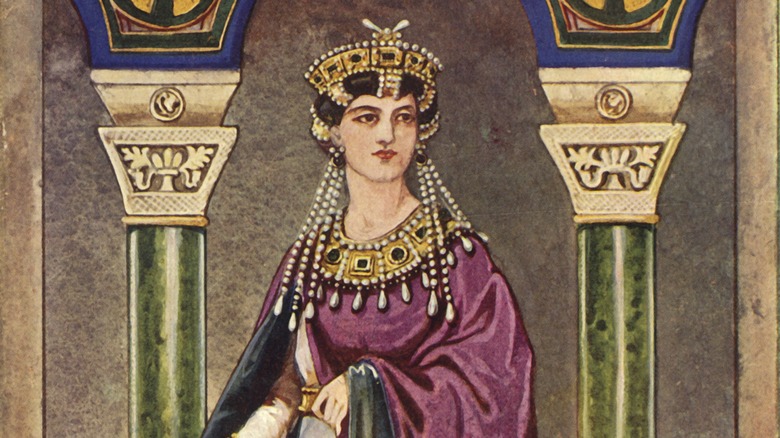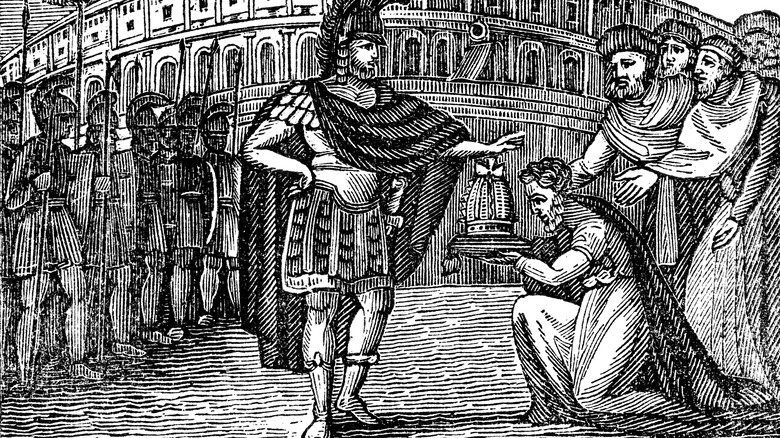How The Assassination Of Amalasuntha Invoked The Wrath Of Justinian I
It's the year 535, and the former Ostrogothic regent and queen of Italy, Amalasuntha, lives in exile on an island in the middle of Lake Bolsena, Tuscany (per Britannica). Black sands cover the volcanic lake's shores (via Italy Magazine). One night, Amalasuntha steps into her bath, unaware that it's the last few moments of her life. Though the details are unknown, a group of assassins steels into her bath and murders the banished queen.
From the day of her birth, Amalasuntha's life was at the mercy of three powerful and opposing forces. The Ostrogoth nobility with which she shared a common heritage and culture urged their queen to align herself with Ostrogothic tradition. Meanwhile, the Byzantine Empire, vying to recapture Western Europe, supported her rule, albeit conditionally. Furthermore, her Italian subjects still maintained their Roman culture and hoped to see themselves reflected in their queen (via ThoughtCo).
A family torn between the Goths and the Romans
Amalasuntha inherited these political tensions from her father, Theodoric the Great (above), the self-appointed Ostrogothic King of Italy. Theodoric, son of Theodemir, an Ostrogothic chieftain, grew up in Constantinople as a hostage to the Roman emperor, as a sign of trust between the Ostrogoths and Rome (per (Britannica). Theodoric grew up with a dual identity as an Ostrogoth noble trained in Roman culture and tradition. This allegiance to both the Goths and Rome would bring him great power and spell disaster for his daughter Amalasuntha.
Once Theodoric reached adulthood, the Roman Emperor Zeno ordered him to overthrow the barbarian Odoacer and take back Italy for the Roman Empire. Theodoric's campaign succeeded, but instead of ruling upon Rome's behalf, he named himself king, even dressing in regal purple robes. Zeno seems to have complied with this unusual move. Though he called himself King, Theodoric's rule was still dependent upon Roman support for its legitimacy.
Amalasuntha was born in 498 in Tuscany, the same region where she would eventually meet her end. The young royal inherited her father's appreciation of Roman culture. Theodoric provided her with a Roman education in the arts, history, literature, and languages (via Encyclopedia). As a result, she could speak Latin, Greek, and Gothic (per ThoughtCo). While this education proved to be enriching, it also alienated her from the Ostrogothic nobility that hoped to see her as Ostrogothic first and foremost.
Amalasuntha follows in her father's footsteps
As Amalasuntha grew older and joined the political arena, tensions worsened. Amalasuntha married Eutharic, a Goth from Spain, to appease the Ostrogoths by allying with another Goth (per ThoughtCo). With Eutharic, she had two children, and her son Athalaric soon became heir to the throne after Eutharic died. Tragically, their daughter, Matasuntha, would be the sole survivor of the family line by the time she reached adulthood (via "The Power Game in Byzantium").
When Theodoric died in 526, Amalasuntha became the regent since Athalaric was 10 years old at the time. Amalasuntha's rule toed the line between her father's Ostrogothic roots and the Byzantine Empire that supported her authority. Her fellow high-ranking Ostrogoths resented the preference she showed Byzantine and Roman customs, such as her pastime as a patron of arts (per Britannica). Only further increasing resentment, she educated Athalaric in the Roman fashion — as her father had for her — focusing on literature, history, and language. Instead, the Ostrogoths vied for Athalaric to be trained as a soldier in the Gothic tradition.
Amalasuntha begins her rule
Aware of the bitter and resentful forces at work, Amalasuntha moved to secure legitimacy for her rule and the safety of her children. She reached out to the Byzantine Emperor Justinian. The two agreed that were she ever deposed by outside forces, she would move herself and the Ostrogothic wealth to the Byzantine city of Constantinople. Mysteriously, this did not happen when she was later exiled (per Britannica). Though this agreement may have provided Amalasuntha with a sense of security, it only increased the danger for her. By seeking Justinian's help, she further alienated her from her Ostrogothic compatriots (via Encyclopedia.com).
To make matters worse, Amalasuntha's communications with Emperor Justinian may have sparked the jealousy of his wife, Empress Theodora (above). As historian Procopius of Caesaria describes in "The Secret History" (per ThoughtCo): "Theodora, reflecting that the lady [Amalasuntha] was well-born and a Queen, more than easy to look at and a marvel at planning intrigues, became suspicious of her charms and audacity and fearing her husband's fickleness, she became not a little jealous, and determined to ensnare the lady to her doom."
Indeed, doom started to circle Amalasuntha. In 533, she intercepted a plot to assassinate her organized by Ostrogoth nobility. Hoping to show that she would punish treason, Amalasuntha executed three of the supposed plotters. Instead of instilling fear in those who questioned her, the executions only worsened matters. In the eyes of the Ostrogoths, she was willing to kill her own.
Death closes in
After her son Athalaric died in 534, Amalasuntha became Queen of the Ostrogoths (per Britannica). Hoping to quell tensions between herself and the Ostrogoth nobility finally, she married her cousin Theodahad, also an Ostrogoth, and named him king (via Encyclopedia.com). This move backfired. Theodahad, allied with Amalasuntha's enemies, exiled her to Lake Bolsena in Tuscany. She did not escape to Constantinople as she hoped and as Justinian had promised.
Not too long after, assassins murdered Amalasuntha as she bathed. Her assassins were supposedly the family members of those she'd executed as punishment for the first assassination attempt, though other suspicions abounded. Some say that Emperor Justinian had attempted to marry Amalasuntha to solidify Italy's place within the Byzantine Empire. Were this true, both Empress Theodora and Theodahad would have been threatened, further increasing ill will toward Amalasuntha from many sides. Others say that even Justinian himself may have ordered the assassination.
Emperor Justinian takes back Italy
After Amalasuntha's assassination, Justinian quickly turned on Theodahad. The Emperor sent his general Belisarius to overthrow Theodahad and begin the recapture of Italy from the Goths (per ThoughtCo). Whether this move was out of revenge for the death of a friend (possibly love interest) or to capitalize on a period of instability is unknown. Regardless, Amalansutha's death sparked the Byzantine Empire's retaking of the Roman Empire's former western territories, including Italy.
Amalasuntha's family lived on through her daughter, Matasuntha (via ThoughtCo). At first, Matasuntha married Witigus, who briefly followed Theodahad as King of Italy and clashed against Belisarius, Justinian's general (per Britannica). Not long after, she married Justinian's close relative Germanus and settled in Constantinople. There, Justinian named her Patrician Ordinary, a position of high nobility and influence (via National Geographic). Though the whims and wills of outside powers dictated Amalansutha's life, in the end, she was able to ensure her daughter's safety. That personal victory resides next to Amalasuntha's empire-transforming legacy.





